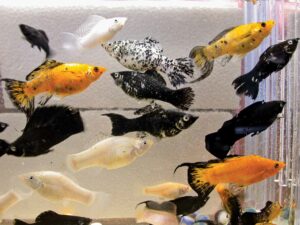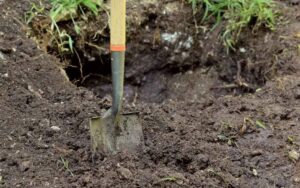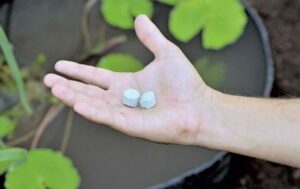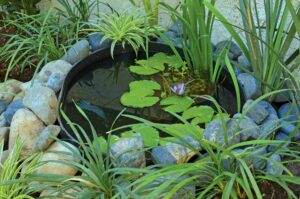A small pond at home
An element that brings beauty and calm into the garden, is an opportunity to enjoy watching the plants grow and small aquatic animals.
LOCATION AND DEPTH
A pond should be located in a place with little pedestrian movement that receives at least five or more hours of sunlight per day.
Secluded corners of a garden are a perfect location. The depth ensures the stability of the water temperature; in extreme climates, either by hot or cold, a minimum of 60 cm depth is required. For climates with moderate temperatures, that do not exceed 30° C, a depth of 40 cm is adequate.
In any case the depth shouldn’t be greater than one meter.

Photography: Molino Lab
Use a small shovel, a pick, and a rake for this project, river stones of different sizes, volcanic rock or tezontle, and anti-chlorine solutionfor ponds.
MATERIALS
Using a plastic tin or barrel is the simplest way to contain water, since they’re made of a very strong material and you can get them from recycling.
Make sure it is free of residue before use. Cut the container to the height the pond will need to give the proper depth according to the previous step (in our example we gave a depth of 60 cm due to the high temperatures of the Yucatan Peninsula).

Illustration: Bettina Vargas
PLANTS AND FISH
Terrestrial plants for exterior decoration, a marsh aquatic plant, a creeping submerged aquatic plant, a floating aquatic plant are needed (on the plantation map you can consult the species we used).
As well as some fish that do not exceed 10 cm, for example Guppys (Poecilia reticulata), Mollys (Poecilia sphenops) or Gambusias (Gambusia yucatana).
Once in the pond, the fish will get their food from nature, eliminating insects like mosquito larvae.

Gruppys (Poecilia reticulata) Photography: Animales.uncomo.com

Mollys (Poecilia sphenops) Photography: C. Moormann.. 2010
With the shovel make a hole of 10 cm smaller than the total height of the barrel. With the pick remove the stones that can damage the container.

Photography: Molino Lab
Insert the container. With the shovel and rake fill the empty space with soil, so it stands firm in place.
A 10 cm edge of the tin will be above ground level; this prevents heavy rocks, soil, leaves and other elements from entering the pond during heavy rains.

Photography: Molina Lab
Pour the small sack of volcanic rock or tezontle until you have created a layer of 5-10 cm deep.
This background material promotes the growth of the bacteria responsible for the nitrification cycle.

Photography: Molino Lab
Fill the container with water to the brim. Add the anti-chlorine solution according to the manufacturer’s instructions.
This solution protects fish from the harmful effects of chlorine that the water may contain.

Photography: Molino Lab
Put the plants in the water, making sure that each plants is at its adequate level.
Each one will be planted in a pot with soil.
The marsh plant should have its leaves outside the water; to adjust its height another plastic pot can be placed underneath.

Photography: Molino Lab
Place the floating aquatic plant in the water, its leaves must be on the surface.
If one falls slightly under, don’t worry, it will grow rapidly until it reaches the surface.

Photography: Molino Lab
The creeping water plant will be completely submerged.
Insert the roots in the substrate using your finger and put a small stone on top to keep them set; as the roots grow they will look for the substrate to hold on.

Photography: Molino Lab
Plant around the pond various species, we recommend that the leaves of the aquatic and terrestrial species are similar, creating continuity between the pond and its surroundings, disguising the edge.

Photography: Molino Lab
Place the river stones between the plants creating your own design, play with the variety of colors, shapes and textures of the rocks to fill the space with the beauty of these natural elements.

Photography: Molino Lab
Put the bag where you have transported the fish into the water of the pond for at least 30 minutes; this will help the fish adapt to the temperature of the new environment.
Then, open the bag and plunge it so the fish can swim out of it.

Photography: Molino Lab
To keep the plants beautiful and healthy in the pond, once a month fertilize the soil from the submerged pots, burying a fertilizer tablet for aquatic plants.

Photography: Molino Lab
Plant species and fish will filter the water waste quickly by balancing this small aquatic system.

Photography: Molino Lab








